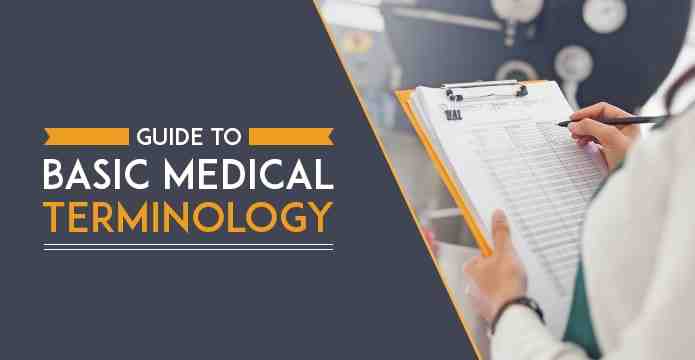As a medical biller or medical coding specialist, he/ she have to assign specific codes based on what the medical provider finds at the patient visit. It means is that the coder must be able to understand and interpret the provider’s written progress notes from the visit, and translate them into the correct codes. A good understanding of basic medical terminology helps us to understand the doctor’s notes more precisely and we will be better able to assign the correct code to the patient’s office visit. This understanding is even more important in speciality medical fields. These may require an in-depth understanding of medical terminology and the need for a very specific diagnosis, like in oncology.
Guide To Medical Terminology
Medical terms generally have 3 parts:
- Roots
- Prefixes
- Suffixes
When they are put all together, the three parts of the word create a more specific medical term. Some medical terms may have all three parts, whereas others might have only one or two.
Root Words are the part of the word that can stand alone as the main part of the medical term. It holds the fundamental meaning of the phrase. Sometimes, medical terms can have more than one root. Here’s a brief list of root words and their meanings:
| Root Word | Meaning |
|---|---|
| Cepahl/o | head |
| Chrom | color |
| Enter/o | intestine |
| Derm/o | skin |
| Gastr/o | stomach |
| Hem/o, Hemat/o | blood |
| My/o | muscle |
| Myel/o | spinal cord |
| Onych/o | nail |
| Oste/o | bone |
| Phag | eat or swallow |
| Phleb/o | vein |
| Pulm/o, Pulmon/o | lungs |
| Synov/i | synovial fluid, joint, or membrane |
| Thromb/o | clot |
| Vas/o | vessel or duct |
Prefixes are typically attached to the beginning of words to modify their meanings. They usually specify the location, time, or number. A prefix (in front of a word) or suffix (at the end) can put an unknown word into perspective. Here’s a brief list of common prefixes and their meanings:
| Prefix | Meaning |
|---|---|
| A- | without, absence of |
| Ab- | away from |
| Ad- | toward, near |
| Ante- | before |
| Ec-, Ect/o- | out, outside |
| End/o- | in, within |
| Mon/o- | one |
| Peri- | surrounding |
| Poly- | many, much |
| Post- | after, behind |
| Trans- | across, through |
| Supra- | above |

Suffixes are typically attached to the end of word, to change their meanings. They usually indicate the procedure, condition, disorder, or disease. Here’s a brief list of common suffixes and their meanings:
| Suffix | Meaning |
|---|---|
| -algia | pain |
| -centesis | puncture, tap |
| -desis | binding, fusion |
| -ectomy | excision, surgical removal |
| -emia | blood |
| -graphy | act of recording data |
| -pexy | surgical fixation |
| -plasty | plastic repair/surgery, reconstruction |
| -sclerosis | hardening |
| -tripsy | crushing |
| -uria | urine, urination |
Putting it all together (with example). By understanding the root words, prefixes and suffixes of medical terminology, we can put together the meaning of a medical term easily. Example: The word rhinorrhea can be broken down to understand its meaning.
| Root word | Meaning |
|---|---|
| Rhin/o- | -nose |
| Suffix | Meaning |
|---|---|
| -rrhea | -flow, discharge |
Definition
Using basic medical terminology, rhinorrhea means discharge from the nose – a runny nose. A good tip when coding difficult medical terms is to always use a current medical dictionary
Basic Medical Terminology List
Now that word formation makes more sense, we can move onto specific terms and common language used in healthcare. It can still be used as the basis for a quickfire medical terminology test. Allied health workers have all manner of different motivations for joining healthcare. However, there are umbrella terms and departmental definitions that link them all together. Here are some examples:
- Anatomy: Parts of the body and its general structure.
- Gynecology: Study and treatment of the female urinary tract and reproductive organs.
- Hematology: Treatment of blood diseases and malignancies.
- Microbiology: Related to bacterial and viral infections.
- Neonatal: Special care for newborn babies with high dependency needs.
- Neurology: Related to the disorders of the brain, spinal cord, or general nervous system.
- Oncology: Chemotherapy treatments for cancer.
- Pathology: The names for disorders and diseases.
- Pediatrics: Medical assistance of infants.
- Psychiatry: The study and treatment of mental disorders.
- Rheumatology: Related to musculoskeletal disorders (bones, joints, muscles, etc.).
- Surgery: Physical operative procedures.
- Urology: Related to problems with the bladder and kidneys.
Medical Dictionary Descriptions
Descriptions for what is happening to patients in both diagnosis and general conversation are the same across the board. Learn the meanings and you’ll progress much faster. Here are some common descriptive words when talking about patients and circumstance:
- Abatement: A reduction in severity of symptoms.
- Abiotic: Not related to living organisms.
- Abortive: Cutting short the course of a disease.
- Abrasion: Friction wearing away of the top layer of skin.
- Abruption: A sudden breaking away or breaking off.
- Accessory: Extra or supplementary to the main element.
- Ambulatory: Ability to walk.
- Analgesia: Loss of pain where pain would normally be evident without loss of consciousness.
- Benign: An abnormal growth that is not life-threatening.
- Cavity: Hollow space in the body containing one organ or more.
- Compression: To apply pressure to stop bleeding or prevent further injury.
- Etiology: The cause of a certain condition.
- Exacerbation: Deterioration of a condition.
- Hematemesis: Blood in vomit.
- Iatrogenic: A condition that appears as a result of treatment of another condition.
- Idiopathic: Of unknown cause.
- Intractable: Difficult to cure or alleviate.
- Referred pain: Pain that is felt in another area to the original source of this pain.
- Reflux: Going in a backward direction.
- Remission: Disappearance of signs of disease.
- Stimulus: Elicits a physiological response.
- Subcutaneous: Just beneath the skin.
- Syndrome: A set of symptoms that indicate towards a certain condition, disease or abnormality.








